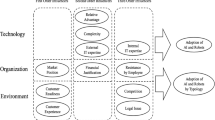Abstract
Although AI and service robot applications have become very popular in many domains recently, many of them are specific applications and it is still difficult to develop integrated intelligent applications such as a robot teahouse and teaching assistant robots. To develop such integrated intelligent applications, we need integrated intelligent application platforms that have AI integration and agile process facilities. From the above background, we are currently developing PRactical INTElligent aPplicationS (PRINTEPS), which is a platform for developing integrated intelligent applications by combining only five types of modules, namely knowledge-based reasoning, spoken dialogue, image sensing, motion management, and machine learning. This paper proposes a workflow editor in PRINETPS based on a service-oriented architecture and a Robot Operating System that enables real-time parallel processing for multiple robots and sensors by integrating the five types of modules. The editor also supports not only developers but also domain experts in updating workflows frequently. This paper also proposes a novel method to integrate signals acquired through image sensing with knowledge (ontologies and business rules) using C-SPARQL and Semantic Web Rule Language. To evaluate PRINTEPS, we developed a robot teahouse application including customer reception and guidance to table services using a humanoid robot with PRINTEPS. Through this case study, we demonstrated that the behaviors of the robot can be modified by changing the workflow, the ontology, and the rules.















Similar content being viewed by others
References
Printeps web site. (2016). http://printeps.org/
Barbieri, D. F., Braga, D., Ceri, S., Della Valle, E., & Grossniklaus, M. (2010). C-SPARQL: A continuous query language for RDF data streams. International Journal of Semantic Computing, 4(1), 3–25. https://doi.org/10.1142/S1793351X10000936.
Boyer, J., & Mili, H. (2011). Agile business rule development: Process, architecture, and JRules examples. Berlin: Springer. https://doi.org/10.1007/978-3-642-19041-4.
Chen X, Ji J, Jiang J, Jin G, Wang F, Xie J (2010) Developing high-level cognitive functions for service robots. AAMAS
Choi, D., Ha, J., Jung, M., Park, W., & Park, H. (2015). Development of robot scenario script language and tool for non-expert. Journal of Automation and Control Engineering, 3(6), 498–502.
Datta C, Jayawardena C, Kuo IH, MacDonald BA (2012) RoboStudio—a visual programming environment for rapid authoring and customization of complex services on a personal service robot. IROS
Della Valle, E., Ceri, S., van Harmelen, F., & Fensel, D. (2009). It’s a streaming world! Reasoning upon rapidly changing information. IEEE Intelligent Systems, 24(6), 83–89.
Fowler, M. (2010). Domain specific languages (1st ed.). Boston: Addison-Wesley.
Hertzberg, J., Jianwei, Z., Zhang, L., Rockel, S., Neumann, B., Lehmann, J., et al. (2014). The RACE project–robustness by autonomous competence enhancement. KI, 28(4), 297–304.
Krafzig, D., Banke, K., & Slama, D. (2004). Enterprise SOA: Service-oriented architecture best practices (the Coad series). Upper Saddle River: Prentice Hall.
Lemaignan, S., Warnier, M., Sisbot, E. A., Clodic, A., & Alami, R. (2016). Artificial cognition for social human–robot interaction: An implementation. Artificial Intelligence, 247, 45–69.
Nishimura R, Takase Y, Nakano Y (2016) Development environment of spoken dialogue system based on PRINTEPS. The 30th annual conference of the Japanese Society for Artificial Intelligence, 4C4-2 (in Japanese)
Pot E, Monceaux J, Gelin R, Maisonnier B (2009) Choregraphe: A graphical tool for humanoid robot programming. In: RO-MAN 2009—The 18th IEEE international symposium on robot and human interactive communication, IEEE, pp 46–51
Quigley M, Conley K, Gerkey BP, Faust J, Foote T, Leibs J, Wheeler R, Ng AY (2009) ROS: An open-source robot operating system. In: ICRA workshop on open source software
Tenorth, M., & Beetz, M. (2013). Knowrob: A knowledge processing infrastructure for cognition-enabled robots. International Journal of Robotics Research, 32(5), 566–590. https://doi.org/10.1177/0278364913481635.
Waibel, M., Beetz, M., Civera, J., D’Andrea, R., Elfring, J., Galvez-Lopez, D., et al. (2011). Roboearth—a world wide web for robots. IEEE Robotics and Automation Magazine, 18(2), 69–82. https://doi.org/10.1109/Mra.2011.941632.
Yamaguchi T (2015) A platform printeps to develop practical intelligent applications. In: Adjunct proceedings of the 2015 ACM international joint conference on pervasive and ubiquitous computing and proceedings of the 2015 ACM international symposium on wearable computers, ACM, UbiComp/ISWC’15 Adjunct, pp 919–920. https://doi.org/10.1145/2800835.2815383
Zander, S., Heppner, G., Neugschwandtner, G., Awad, R., Essinger, M., & Ahmed, N. (2016). A model-driven engineering approach for ROS using ontological semantics. CoRR cs.RO.
Acknowledgements
We are grateful to Prof. Hideo Saito, Dr. Yuko Ozasa, and Mr. Yusuke Nakayama for implementing the image-processing modules, to Mr. Yu Sugawara and Mr. Daiki Marukawa for implementing the knowledge modules, to Prof. Yukiko Nakano and Dr. Ryota Nishimura for implementing the spoken dialogue system and modules, and to Prof. Masaki Takahashi, Dr. Anaynori Yorozu, and Mr. Jun Kurosu for implementing the motion management modules. We are also grateful to North Grid corporation for implementing the workflow editor. This work was supported by JST CREST Grant Number JPMJCR14E3, Japan.
Author information
Authors and Affiliations
Corresponding author
Rights and permissions
About this article
Cite this article
Morita, T., Nakamura, K., Komatsushiro, H. et al. PRINTEPS: An Integrated Intelligent Application Development Platform based on Stream Reasoning and ROS. Rev Socionetwork Strat 12, 71–96 (2018). https://doi.org/10.1007/s12626-018-0020-y
Received:
Accepted:
Published:
Issue Date:
DOI: https://doi.org/10.1007/s12626-018-0020-y




